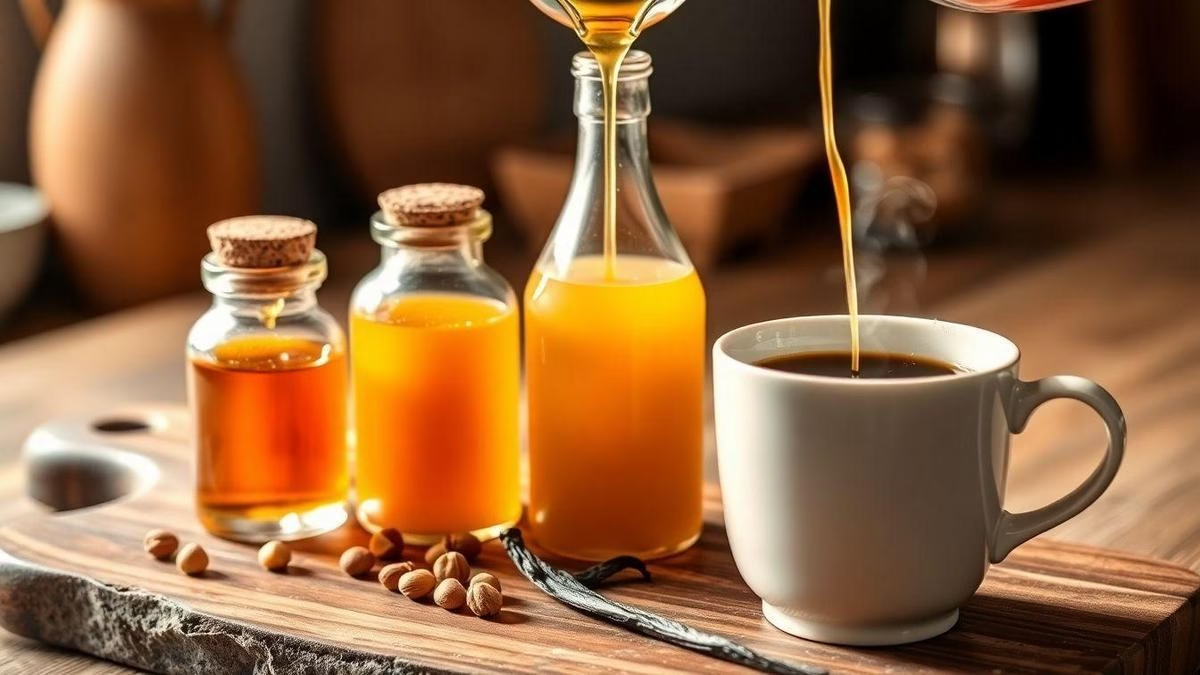Homemade Coffee Syrups: Vanilla, Hazelnut and Caramel
Homemade Coffee Syrups: Vanilla, Hazelnut and Caramel is your go-to guide for making café-quality syrups at home. You’ll learn stovetop basics, how to make a simple syrup (equal parts sugar and water), clear stovetop caramel tips for glossy results, must-have tools and ingredients, quick DIY vanilla, hazelnut, and caramel recipes, plus a step-by-step hazelnut method using natural flavoring. Find sugar-free and vegan swaps, simple ways to balance flavor and strength, and smart storage and safety tips so your syrups last. Finally, learn how to scale batches, package gifts, and handle allergy and labeling notes before you share.
Key Takeaway
- Make syrup with equal parts sugar and water (1:1) for a standard simple syrup.
- Stir in vanilla, hazelnut, or caramel flavor while warm (or add extracts after cooling).
- Cool and store syrup in the fridge; shelf life depends on ingredients.
- Taste and adjust sweetness to your liking.
- Add syrup to coffee, lattes, or desserts.
Stovetop basics for Homemade Coffee Syrups: Vanilla, Hazelnut and Caramel
Making syrups on the stovetop is like tending a small campfire: watch, stir, and adjust heat so nothing scorches. Start with a simple 1:1 sugar-to-water syrup. Keep heat low to medium and aim for a gentle simmer — a hard boil darkens flavor and can cloud the syrup. See Chemistry of caramelization and browning.
Use a heavy-bottomed pan to spread heat evenly. Stir early with a wooden spoon or heatproof spatula until sugar dissolves; stop stirring once dissolved to avoid crystals. If infusing nuts or beans, add them after dissolution and steep off heat for fuller flavor.
Finish by cooling and straining through a fine-mesh sieve or cheesecloth to catch solids. Cool completely before bottling in a clean jar. Store in the fridge (timing varies by recipe) or add alcohol as a preservative for longer life.
Once you make your own syrup, store-bought flavors will taste flat by comparison.
How to make a simple syrup base (1:1 sugar to water) for DIY vanilla coffee syrup recipe
Measure equal parts granulated sugar and water (1 cup sugar 1 cup water yields ~1 cup syrup after some loss). Combine in a small saucepan and heat over low until the sugar dissolves — a simmer is enough.
For vanilla: split a vanilla bean, scrape seeds into the syrup and add the pod; steep off heat 20–30 minutes for deep flavor. If using extract, add 1/2–1 tsp per cup after the syrup cools. Strain before bottling. See the Home preservation guidance for syrups for jar-sterilizing methods and safe bottling tips.
Stovetop caramel method and tips for stovetop caramel coffee syrup
Caramel syrup starts by melting sugar alone (dry) or with a bit of water (wet). For control, use the wet method: 1 cup sugar 1/4 cup water, simmer until amber. Watch closely — amber can turn to burnt fast.
Carefully add hot water (about 3/4–1 cup) to the caramel to make a syrup, stirring gently — expect steam and bubbling. To prevent crystallization, add a teaspoon of corn syrup or a pinch of salt, or gently swirl the pan. For a richer syrup, stir in 1 tsp butter or a splash of cream after removing from heat.
Tip: Cool caramel slightly before adding water; add water slowly to avoid violent bubbling.
Essential tools and ingredients for stovetop syrup making
You’ll need: heavy saucepan, measuring cups and spoons, wooden spoon or heatproof spatula, fine-mesh sieve or cheesecloth, clean bottles or jars. Basic ingredients: granulated sugar, water, and flavorings — vanilla beans or extract, toasted hazelnuts or hazelnut extract, and sugar (and optionally butter/cream) for caramel. Toast whole nuts to deepen aroma.
| Syrup | Base Ratio | Flavoring / Amount | Quick Notes |
|---|---|---|---|
| Vanilla | 1:1 sugar to water | 1 vanilla bean (per 1 cup syrup) or 1/2–1 tsp extract | Steep bean off heat 20–30 min; strain |
| Hazelnut | 1:1 | 2 tbsp toasted crushed hazelnuts or 1 tsp extract | Toast nuts 5–7 min; infuse warm syrup 30–60 min |
| Caramel | Start with 1 cup sugar ( 1/4 cup water wet method), then add 3/4–1 cup hot water | Optional butter/cream 1 tsp | Make caramel to amber, add water slowly, strain |
Quick DIY vanilla, hazelnut and caramel coffee syrup recipes you can follow
You can make café-style flavor at home fast. Homemade Coffee Syrups: Vanilla, Hazelnut and Caramel give your morning cup a big lift without fancy gear. Start with a 1:1 syrup for pourable syrup or 2:1 for thicker, dessert-style syrup. Add vanilla bean or extract, toasted hazelnuts or hazelnut extract, and real caramel for a deep buttery finish. Small tweaks—like a pinch of salt—can transform the result.
Use these as a starting point and tweak to taste. Store syrups in clean bottles in the fridge for up to 2–3 weeks depending on ingredients.
| Syrup | Base ratio (sugar : water) | Flavoring per batch (1 cup syrup) | Notes |
|---|---|---|---|
| Vanilla | 1:1 or 2:1 for thick | 1 vanilla bean split or 1 tsp extract | Simmer with bean, strain, bottle |
| Hazelnut | 1:1 | 1/2 cup toasted chopped hazelnuts 1 tsp vanilla | Steep nuts in hot syrup, strain well |
| Caramel | Start with 1 cup sugar (caramelize) then add 3/4 cup hot water | 2 tbsp butter, pinch salt, 1 tsp vanilla | Make caramel, convert to syrup by adding water carefully |
Step-by-step DIY hazelnut coffee syrup recipe with natural flavoring
Toast hazelnuts until fragrant and slightly dark. Cool, then smash or chop. In a small pot combine 1 cup sugar and 1 cup water and heat until sugar dissolves. Add chopped toasted hazelnuts and a vanilla pod or 1 tsp extract; simmer 5 minutes.
Turn off heat and steep 30 minutes to a few hours for stronger flavor. Strain through fine mesh or cheesecloth into a clean jar. Refrigerate; it will last 2–3 weeks (see storage notes). Tip: Toast hazelnuts on a baking sheet for 8–10 minutes at 350°F; rub in a towel to remove skins.
DIY caramel coffee syrup recipe with measured steps for consistency
In a heavy saucepan, spread 1 cup granulated sugar in an even layer and heat over medium without stirring (or use the wet method with 1/4 cup water). As edges melt, gently swirl until amber. Remove from heat and slowly add 3/4 cup boiling water — expect steam and bubbling. Stir to dissolve.
Return to low heat, add 2 tbsp unsalted butter and a pinch of salt; simmer 2–3 minutes. Stir in 1 tsp vanilla once cooled a bit. Cool before bottling. Use 1 tbsp at a time in coffee; adjust to taste. Store in fridge up to 2 weeks.
Simple ratios to scale each homemade vanilla coffee syrup recipe
- 1:1 sugar to water — standard syrup.
- 2:1 sugar to water — thicker, more cling for milk and desserts.
- Vanilla: 1 split bean or 1 tsp extract per cup syrup.
- Hazelnut: ~1/2 cup toasted nuts per cup syrup (or extract to taste).
- Caramel: caramelize 1 cup sugar, add ~3/4 cup hot water to yield ~1 cup syrup.
Multiply these numbers by desired batch size.
Sugar-free and vegan options for Homemade Coffee Syrups: Vanilla, Hazelnut and Caramel
You can make rich, syrupy flavors without sugar or animal products while keeping café feel. Swap sugar for low-cal sweeteners and replace dairy/butter with plant-based fats and extracts. Think of syrup as three parts: sweetener, flavor, and body.
Erythritol, stevia, monk fruit, or allulose cover sweetness. For body and gloss use vegetable glycerin, a small amount of neutral oil, or reduced aquafaba. Use extracts and natural oils for aromatic notes: vanilla extract or bean, toasted hazelnut extract or oil, and caramel flavor from brown-sugar alternatives plus coconut cream or vegan butter.
Low-cal sweeteners behave differently when heated — some recrystallize or develop bitter notes — so simmer gently and test ratios. Refrigerate and use within 10–14 days for most sugar-free versions. See this Overview of sugar alternatives and behavior for guidance on common substitutes and their limitations.
Tip: If a sugar-free syrup tastes flat, add a pinch of salt or a drop of lemon juice — acid brightens flavors and salt rounds sweetness.
How to make a sugar-free vanilla coffee syrup using erythritol or stevia
Use a 1:1 ratio by volume for erythritol and water (1 cup erythritol : 1 cup water). Heat gently until dissolved, add a vanilla bean or 1–2 tsp pure vanilla extract, and simmer 5–8 minutes. For stevia, start with a few drops or 1/4 tsp powdered and taste as you go.
Erythritol can recrystallize if overboiled; remove early to keep smooth. To add body, stir in 1 tbsp vegetable glycerin or 1 tsp neutral oil at the end.
Vegan hazelnut coffee syrup swaps using plant-based extracts and oils
Use toasted hazelnut extract or a few drops of toasted hazelnut oil. For a nut backbone, steep toasted hazelnuts in warm plant milk or water, strain, and reduce with your sweetener. For caramel-style richness use coconut cream or vegan butter substitute. Nut oils are potent — add sparingly.
| Ingredient swap | Best for | Quick notes |
|---|---|---|
| Erythritol water | Vanilla, general syrup base | Clean taste, may recrystallize if overcooked |
| Stevia / monk fruit | Low-calorie sweetness | Very sweet — add gradually |
| Vegetable glycerin | All flavors | Adds gloss and body |
| Toasted hazelnut oil / extract | Hazelnut syrup | Use sparingly — concentrated |
| Coconut cream / vegan butter | Caramel and body | Adds richness without dairy |
Safety and taste tips for sugar-free and vegan syrup versions
Keep jars and utensils clean and refrigerate. With less sugar to preserve, use within 10–14 days and discard if off-smelling. Small tweaks (salt, acid, tiny oil drops) fix blandness without hiding main flavor.
Flavor pairing and strength: balance in homemade vanilla coffee syrup and more
Aim for a syrup that sings, not shouts. A 1:1 vanilla syrup gives a gentle lift; 2:1 adds body and cling to milk or cold brew. Taste frequently and adjust: if flavor is too loud, dilute; if it hides behind espresso, boost flavor or reduce water. Beans add depth; extracts add clarity.
When blending vanilla, hazelnut, and caramel, let one lead depending on drink: milk drinks often want caramel front; espresso benefits from hazelnut to cut bitterness. Homemade Coffee Syrups: Vanilla, Hazelnut and Caramel work best when tailored to who will drink them and how.
How to adjust sweetness and intensity for homemade hazelnut coffee syrup
Make a small test batch (e.g., 100 ml) at 1:1 and add toasted nuts or extract in measured amounts. Steep nuts 20–30 minutes; extracts are stronger so add little by little. If flat, try longer steeping or browned nuts. To cut sweetness, lower sugar or swap half for maple or honey. For more body, make a 2:1 syrup; for a lighter touch, dilute after bottling and label.
Pairing vanilla, hazelnut, caramel coffee syrup with milk, espresso and desserts
- Milk drinks: 10–15 ml syrup per 240 ml milk for mild latte. Vanilla smooths, caramel adds buttery finish, hazelnut gives warm roast notes.
- Espresso: 5–8 ml per single shot; use bolder flavors sparingly.
- Desserts: caramel for affogato and whipped cream; hazelnut with chocolate; vanilla for pastries and custards.
Tip: Make a tiny cup diluted to intended strength before bottling to avoid waste.
Measuring and testing flavor strength before bottling
Dilute 1 tsp syrup into 90 ml of the target drink and taste. If stronger is needed, add to the batch and retest. Keep a log: batch date, sugar ratio, flavor amount, and tasting notes. Label bottles with final ratio to repeat favorites.
| Strength | Sugar:Water | Flavor amount (per 100 ml) | Best for |
|---|---|---|---|
| Mild | 1:1 | 0.5–1 tsp extract or 5 g nuts | Iced coffee, milk-forward drinks |
| Medium | 1.5:1 | 1–2 tsp extract or 10 g nuts | Lattes, sweetened espresso |
| Strong | 2:1 | 2 tsp extract or 15 g nuts | Desserts, drizzling, bold espresso |
Storage, shelf life, and food safety for homemade caramel coffee syrup and others
Sugar helps preserve syrups but isn’t a guarantee. If you add dairy, nut oils, or fresh ingredients, the clock speeds up. Keep batches small so you use them while fresh.
Store in clean, airtight glass jars; cool before sealing. Mark the date and use within recommended windows — this keeps consistency and safety. Toss if you see mold, cloudiness, fizz, or sour smell. Refer to the Refrigerator and freezer storage times chart for general storage time guidance.
Homemade Coffee Syrups: Vanilla, Hazelnut and Caramel each behave differently. Plain 1:1 syrups last weeks in the fridge; richer or extract-based syrups can last longer; nutty or dairy-containing versions have shorter lives.
Best practices for refrigerating homemade caramel coffee syrup and vanilla syrup
Cool syrup to room temperature before refrigerating to avoid steam and warped lids. Use glass jars with tight lids and store in the coldest part of the fridge, not the door. Keep a clean spoon for dipping and label each jar with make and discard dates (2–4 weeks typical).
How long homemade hazelnut coffee syrup lasts and signs of spoilage
- Hazelnut syrup with extract simple syrup: 2–4 weeks refrigerated.
- Hazelnut syrup with real nuts or nut oil: 1–2 weeks (rancidity risk).
Signs of spoilage: mold, unusual cloudiness, unexpected bubbles, or sour/fermented smell. Freeze extra syrup in ice cube trays to extend life; thaw carefully and sniff before use.
Sterilizing jars and labeling dates for safe storage
Boil jars and lids 10 minutes or run through the hottest dishwasher cycle; dry on a clean towel. Fill cooled syrup, seal, and label with flavor and date. Suggested discard: 2 weeks for nutty syrups with real nuts, up to a month for plain 1:1 syrups, longer for 2:1 syrups.
| Syrup type | Typical fridge life | Freezer option | Notes |
|---|---|---|---|
| Vanilla (extract, 1:1) | 2–4 weeks | Yes (3–6 months) | Store in glass; label date |
| Caramel (no dairy) | 2–4 weeks | Yes (3–6 months) | High sugar preserves well |
| Hazelnut (extract) | 2–4 weeks | Yes (3–6 months) | Watch for nut oil off-smell |
| Hazelnut (real nuts/oil) | 1–2 weeks | Not ideal | Rancidity risk; make small batch |
When in doubt, throw it out — it’s faster to make fresh syrup than to risk food poisoning.
Quick tip — freeze extra syrup in ice cube trays. Pop cubes into warmed milk or coffee for instant flavor without waste.
Scaling, batch-making, and gift ideas using Homemade Coffee Syrups: Vanilla, Hazelnut and Caramel
You can scale Homemade Coffee Syrups: Vanilla, Hazelnut and Caramel without drama. Treat recipes as ratios: multiply ingredients by the same factor and use larger, wide pots to prevent boil-overs. For caramel, make in batches and add water slowly; for hazelnut, toast and strain or use extract to save time; for vanilla, beans add depth while extract speeds production.
Taste as you go — heat and simmer times change with volume. If cooled syrup is too thick, warm gently and add a splash of water. Label batches with date and recipe notes for consistency.
Batch-making ideas: freeze portions in ice cube trays, make concentrated halves for stronger flavor, or prepare gift sets.
Converting small recipes into larger batches for cafés or gifts
Scaling is straightforward: multiply cups and teaspoons by the batch multiplier. Use a candy thermometer for caramel at larger scale; larger volumes take longer and require careful color monitoring. Strain thoroughly to remove solids that can spoil faster in big jars. Cool before bottling to avoid pressure build-up.
| Batch multiplier | Sugar (cups) | Water (cups) | Flavor | Approx yield (ml) |
|---|---|---|---|---|
| 1x | 1 | 1 | 1 tsp vanilla / 1 tbsp hazelnut extract / make caramel base | ~240 ml |
| 4x | 4 | 4 | 4 tsp vanilla / 4 tbsp hazelnut extract / scale caramel | ~960 ml |
| 8x | 8 | 8 | 8 tsp vanilla / 8 tbsp hazelnut extract / scale caramel | ~1920 ml |
Packaging ideas and labels for a vanilla hazelnut caramel coffee syrup recipe gift
Use clear glass bottles to show color: pale vanilla, amber caramel, warm hazelnut. Cork or flip-top lids add charm. Include a small wooden spoon or handwritten tag with serving suggestion (e.g., 1–2 tbsp in 200 ml milk). Wrap the neck with twine and tuck a coffee bean for rustic flair.
Labels: front — flavor and net volume; back — ingredients, date made, Refrigerate after opening, best-by date, and a fun note. Use waterproof labels or seal with clear tape. For sets, include pairing notes: caramel → lattes, hazelnut → cold brew, vanilla → sweet drip coffee.
Tip: Add a Shake before use sticker and a best-by date.
Legal and allergy labeling notes when selling or gifting syrups
List all ingredients and highlight common allergens (e.g., HAZELNUT). Note dairy if used. Add a Made on equipment that also processes… line if applicable. Include date made, storage instructions, net volume, and contact info or batch number. Check local cottage food or selling regulations. See Labeling and allergen information for foods for official guidance on allergen declarations when packaging syrups.
Conclusion
You now have the roadmap to make café-quality syrups at home. Start with a simple syrup (1:1), mind stovetop heat, and steep or infuse your vanilla, hazelnut, or caramel flavors for real depth. Keep batches small when using fresh ingredients, cool, strain, and refrigerate; toss at the first sign of spoilage. Try sugar-free and vegan swaps for lighter or plant-based options. When you scale, taste often and label everything so you can repeat successes.
Make it yours: tweak sweetness, strength, and body until the syrup sings in your cup. Wrap jars as gifts, freeze extras in cubes, and treat each batch like a small experiment worth savoring. For more tips, recipes, and inspiration, read more at https://guiabebefeliz.com.
Homemade Coffee Syrups: Vanilla, Hazelnut and Caramel — small tools, simple steps, big payoff.

Rafael Souza is a digital marketing specialist and passionate coffee enthusiast. He founded Guiabebefeliz to share practical, easy-to-follow guides for making great coffee at home without needing professional barista skills. His mission is to help readers enjoy better coffee experiences, one cup at a time.






